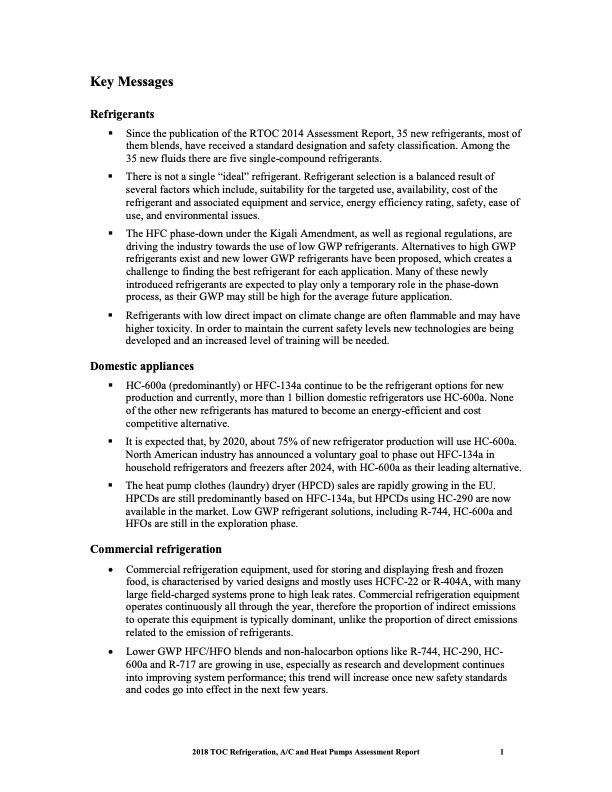
PDF Publication Title:
Text from PDF Page: 014
Key Messages Refrigerants Since the publication of the RTOC 2014 Assessment Report, 35 new refrigerants, most of them blends, have received a standard designation and safety classification. Among the 35 new fluids there are five single-compound refrigerants. There is not a single “ideal” refrigerant. Refrigerant selection is a balanced result of several factors which include, suitability for the targeted use, availability, cost of the refrigerant and associated equipment and service, energy efficiency rating, safety, ease of use, and environmental issues. The HFC phase-down under the Kigali Amendment, as well as regional regulations, are driving the industry towards the use of low GWP refrigerants. Alternatives to high GWP refrigerants exist and new lower GWP refrigerants have been proposed, which creates a challenge to finding the best refrigerant for each application. Many of these newly introduced refrigerants are expected to play only a temporary role in the phase-down process, as their GWP may still be high for the average future application. Refrigerants with low direct impact on climate change are often flammable and may have higher toxicity. In order to maintain the current safety levels new technologies are being developed and an increased level of training will be needed. Domestic appliances HC-600a (predominantly) or HFC-134a continue to be the refrigerant options for new production and currently, more than 1 billion domestic refrigerators use HC-600a. None of the other new refrigerants has matured to become an energy-efficient and cost competitive alternative. It is expected that, by 2020, about 75% of new refrigerator production will use HC-600a. North American industry has announced a voluntary goal to phase out HFC-134a in household refrigerators and freezers after 2024, with HC-600a as their leading alternative. The heat pump clothes (laundry) dryer (HPCD) sales are rapidly growing in the EU. HPCDs are still predominantly based on HFC-134a, but HPCDs using HC-290 are now available in the market. Low GWP refrigerant solutions, including R-744, HC-600a and HFOs are still in the exploration phase. Commercial refrigeration • Commercial refrigeration equipment, used for storing and displaying fresh and frozen food, is characterised by varied designs and mostly uses HCFC-22 or R-404A, with many large field-charged systems prone to high leak rates. Commercial refrigeration equipment operates continuously all through the year, therefore the proportion of indirect emissions to operate this equipment is typically dominant, unlike the proportion of direct emissions related to the emission of refrigerants. • Lower GWP HFC/HFO blends and non-halocarbon options like R-744, HC-290, HC- 600a and R-717 are growing in use, especially as research and development continues into improving system performance; this trend will increase once new safety standards and codes go into effect in the next few years. 2018 TOC Refrigeration, A/C and Heat Pumps Assessment Report 1PDF Image | Heat Pumps Technical Options

PDF Search Title:
Heat Pumps Technical OptionsOriginal File Name Searched:
RTOC-assessment-report-2018_0.pdfDIY PDF Search: Google It | Yahoo | Bing
CO2 Organic Rankine Cycle Experimenter Platform The supercritical CO2 phase change system is both a heat pump and organic rankine cycle which can be used for those purposes and as a supercritical extractor for advanced subcritical and supercritical extraction technology. Uses include producing nanoparticles, precious metal CO2 extraction, lithium battery recycling, and other applications... More Info
Heat Pumps CO2 ORC Heat Pump System Platform More Info
| CONTACT TEL: 608-238-6001 Email: greg@infinityturbine.com | RSS | AMP |